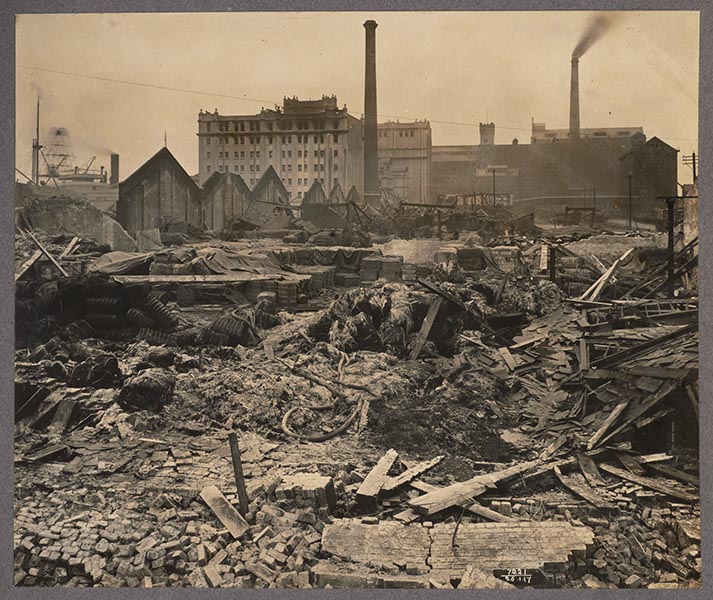Silvertown Explosion 1917
On 19 January 1917 the biggest explosion ever in the metropolis destroyed a large part of Silvertown in East London.
Silvertown was an industrial area fronting the River Thames directly to the south of the Royal Victoria Dock, and east of Bow Creek. It developed in the 1850s and was named after Samuel Winkworth Silver, who established a factory there. Silver’s business prospered and became know as the India-Rubber, Gutta-Percha, and Telegraph Works Company Limited. The factory made some of the first Bell’s patent telephones in the 1880s.
Silvertown was beyond the part of London governed by the Metropolitan Building Act (1843), which controlled the setting up of noxious industries. As a result, many factories were established in Silvertown. Dangerous and unpleasant products were handled and made, such as caustic soda, sulphuric acid, manure, creosote and petroleum. Between the docks, railway lines and industrial premises, workers lived in rows of small densely packed terrace houses.
During the First World War in 1915, a Silvertown chemical plant owned by Brunner, Mond & Co was adapted for the production of trinitrotoluene (T.N.T.), a highly explosive substance. This was ordered by government since explosives were in great demand on the Western Front. The company resisted this development as the surrounding area was densely populated. Even handling T.N.T. was hazardous: many munitions workers found that it turned their skin yellow, caused nausea and chest pains.
Just before 7am on 19 January 1917, a fire started at the works resulting in the detonation of 50 tons of high explosives. A large part of the factory was instantly destroyed together with several nearby buildings and streets. The flour mills and silos on the south side of the Royal Victoria Dock were badly damaged. Across the river on the Greenwich Peninsula, now the site of the Millennium Dome, one of the gas holders exploded.
Although there was a strong response from local communities, the geographical isolation of the area hindered rescue work. In Silvertown 73 people died and 300 were injured. Between 60,000 and 70,000 properties were damaged to some degree. The cost of the damage was estimated at a quarter of a million pounds, an enormous sum at that time.
The day after the explosion, the local authorities set up the Explosion Emergency Committee to oversee rescue and rebuilding work. By mid-February 1917, more than 1,700 men were employed in repairing houses. By August most of the work was complete. The government eventually paid about three million pounds in compensation to the people affected by the disaster.
An inquiry into the incident judged that Silvertown was a totally unsuitable place for a T.N.T. plant and castigated Brunner, Mond & Co for negligence in the running of their works. The report remained secret until the 1950s.
The Silvertown explosion was not the only First World War munition disaster. An explosion on 1 July 1918 at the Chilwell ammunition factory in Nottingham killed 134 workers and injured 250.








